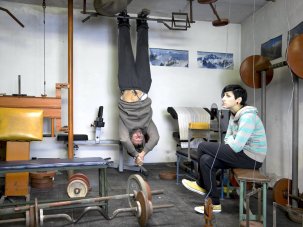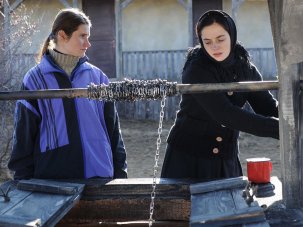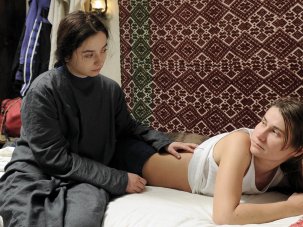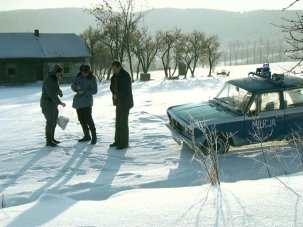Web exclusive

Floating Skyscrapers (Płynące wieżowce)
The ‘East of the West’ strand in the Karlovy Vary International Film Festival focuses on filmmakers from Central and Eastern Europe, a region covering 18 countries. Given that the spate of films dealing with the socio-political history of the Communist past has mostly come to an end, the strand’s raison d’etre needs revision. New types of stories are appearing – including two that I discuss below – but how do they relate to one another or indeed to films from the West?
| The 48th Karlovy Vary International Film Festival runs 28 June–6 July in the Czech Republic. |
Summing up the common themes, Karlovy Vary’s Artistic Director Karel Och observes that “most of the ‘East of the West’ filmmakers have just turned 30, more or less, so are naturally interested in how to have a decent life in a complex, exciting and sometimes hostile world.” This approach certainly accounts for Tomasz Wasilewski’s Floating Skyscrapers (Płynące wieżowce), a drama about the tensions between homo- and bi-sexuality and traditional, repressive family structures in a Poland still struggling to tolerate individual and variant sexual desire.
Kuba (Mateusz Banasiuk), an aspiring young athlete on the cusp of professional break-through, lives in Warsaw with his girlfriend Sylwia (Marta Nieradkiewicz) in the flat of his possessive mother Ewa (Katarzyna Herman). At a straitlaced gallery opening, he meets Michal (Bartosz Gelner), who is gay, and the two immediately connect. After a brief struggle to come to terms with falling in love, they long for nothing more than to be accepted as a couple.
Despite his attempts to come out, Kuba finds his mother and girlfriend are constrained by their deep-seated beliefs, unable to understand that Kuba’s feelings for Mikal are not just temporary and ‘curable’. Carefully composed scenes display Kuba’s emotional turmoil, manifested especially in an intense swimming race: way ahead of everyone else, he suddenly dives deep to the bottom of the pool. Erotic desire is contrasted with shots of steel-blue cityscapes, water, empty parking lots and urban highways, all set against a metallic soundtrack that includes Portishead’s desolate Sour Times.
The sound design is bold: there’s a startling moment where all sound disappears entirely, expressing Kuba’s inner suffocation. Thanks to its intelligently sparse and innovative melding of narrative, sound, editing and cinematography Floating Skyscrapers arrives as a breath of fresh air from Poland – at times it even reminded me of the virtuosity of Joachim Trier’s Oslo, August 31.

Withering (Odumiranje)
Credit: Film Servis Festival Karlovy Vary
In Miloš Pušić’s Withering (Odumiranje), Janko (Branislav Trifunović) returns to his Serbian village after several years in Belgrade. His mother is as possessive as Kuba’s, and expects Janko to settle in the old family home. But he plans to sell the land – his father’s grave there marks the only sign of human interaction with nature – to enable a better future for himself in Zurich. Although cinematically less striking overall, Pušić’s film deserves attention for his skilful deployment of seemingly stereotypical narrative tools, turning his tale into a surprisingly un-traditional drama about a disenchanted young man, longing for nothing more than to cut his family ties and leave behind his village and country.
Both these films grow out of disillusionment with their respective countries. They criticise outdated values and traditions and, in the case of Withering, the impossibility of continuing rural life in a depressed society. The latter film was financed modestly as a Serbian-Swiss co-production – not surprising given the current difficulty of sourcing funding exclusively within Serbia.
Petar Mitrić, an exhibitor in Subotica, and a programmer of two major strands at the European Film Festival in Palić (a showcase of new European film in Serbia), worries that the situation for Serbian cinema is heading from bad to worse. Following the government’s announcement that it would not finance any film in 2013-14, the outlook is now as grim as that in Hungary or Portugal.
“What makes it worse is that there was no legislation for the film industry in the first place,” he says. The latest iteration of Serbia’s Cinema Law has deleted Article 19, which concerned additional funding mechanisms available through National TV, the National Broadcasting Agency or other institutional bodies. “These new changes leave film directors with no alternative” source of funding. Furthermore, Mitrić adds, political changes at the Serbian Film Centre mean that “a new, incompetent and corrupt system will be endorsed.”
Romania is facing similar problems. Its funding commissions have not held their legally a two sessions per year. In April they announced the first round of funding for the first time in 18 months. The situation makes it close to impossible to keep a production company that depend on national resources afloat.
Neither Serbia’s nor Romania’s government supports a digital roll-out in cinemas, yet almost 90 per cent of Serbia’s cinemas are only equipped with 35mm projectors. Serbian distributors meanwhile have announced that from June 2013 there will be no films available for distribution on 35mm – a perfect Catch-22.
Despite all this, the growth of the EU and consequent economic shifts have resulted in closer working relationships between co-producers, labs and networks, enabling young filmmakers to realise their vision. Co-productions between the ‘old’ and ‘new’ European nations have increased significantly, allowing for a genuine fusion of East and West. Och sees the benefit of this expanded yet closely entwined Europe, but “my perspective and position is a rather comfortable one compared to, for example, producers. I have always been interested in how skilful [producers] are in leaving the local [behind] to become partners for international co-productions.”
For instance, he explains, around 25 features are made annually in the Czech Republic, out of which five to seven are “worth watching”. If successful they can reach up to 100,000 national admissions, but, “if you come with a daring script, innovative formal approach and less known actors, you’re happy with 20-30,000 admissions.” One outstanding case he mentions is the first Czech-Norwegian co-production, Detective Downs (currently in post-production), directed by Bård Breien, whose debut The Art of Negative Thinking was a highlight at KVIFF 2007.
“Old and new EU countries always have things to learn and exchange between them,” argues Ada Solomon, currently one of Romania’s most prolific producers (Child’s Pose, Medal of Honour, Principles of Life, The Happiest Girl in the World). “They have the knowledge and the means; we have the stories and an amazing pool of talent.” Using difference creatively is crucial to maximising the mutual benefit of each project. “This is where a producer enters the game – finding creative ways to use different opportunities in every country. Everyone comes with their own heritage but, by collaborating with others, you are expanding your vision and sharing it… These cross-cultural encounters are what stimulate me most.”
And having a presence at foreign markets and world sales agents working passionately to promote and circulate the films is an absolute necessity. “It’s not only commercially efficient, but also a pleasure for the soul to see how people from a completely different culture might fall in love with your film, the way they understand it and add to its value by circulating it,” Solomon says. It’s not getting any easier but, she argues, Romanian producers would not have succeeded in achieving the level of recognition they have without their Western partners, whether they be co-producers, sales agents, distributors or festival programmers scouting for new forms of expression.
Seeing one’s films receive more public recognition in foreign territories can be “somehow painful,” says Solomon. “In France… but also in the UK, there is an interest in Romanian films and most of the time the results are much more significant.” After 1989 Romanians stopped going to the cinemas – which had been seen as centres of propaganda – a habit which, once gone, can be hard to re-establish.
Thankfully there’s a growing inclination at a handful of cinemas to show arthouse titles, “but here we come to the problem of the authorities and their policy towards culture, questioning whether to integrate cinema as a part of the contemporary arts and an important cultural tool,” says Solmon. Hence it is film festivals that play the crucial role in creating awareness of films from ‘small’ countries, which have no stars and speak a ‘low-circulation’ language. “Without international festivals, the New Romanian Cinema would not be known.”

2013 Berlin Film Festival Golden Bear winner Child’s Pose (Pozitia Copilului)
Credit: Film Servis Festival Karlovy Vary
Nonetheless, in the last 12 months a small miracle has happened at the Romanian box office. Tudor Giurgiu’s Of Snails & Men and Cristian Mungiu’s Beyond the Hills have reached previously unknown box office highs for such works. Their achievement was followed by the even greater success of Călin Peter Netzer’s Berlinale winner Child’s Pose (Pozitia Copilului), which reached almost 100,000 admissions in a country that doesn’t generally operate cinemas at all, let alone the arthouse variety. (According to Solomon, “we face the quasi-monopoly of one multiplex operator which has over 55 per cent of the market share.”) She sees Child’s Pose as an exception in reaching so many multiplexes. Her team created a genuine awareness of the film through a carefully structured marketing campaign with media support. “That the Golden Bear award was featured on TV as breaking news was a driving factor for its success.”
To highlight the differences between neighbouring countries, Solomon takes the example of Poland. “In Poland the situation is more stable. We watch them with admiration and a bit of envy, because things there are connected in terms of the economic situation and existing cinema networks.”
Until the crash of Hungary’s film fund two years ago, production conditions were better there than in Romania, but a healthy competition with Hungarian filmmakers persists. “We are working a lot with them, either as co-producers for our films, by having Romanian actors playing in Hungarian films or by using their post-production facilities.” Hungary’s tax incentives also help to finance minority co-productions, a tool Romania lacks. Having a similar rate of currency also makes collaboration easier.
The significant link for Solomon is the Transilvania International Film Festival (founded in 2001). “It is a phenomenon that grew together with the New Romanian Cinema. It’s an incredible tool for promoting our films, but also for discovering the latest jewels from around the world and for showing visitors and younger generations the heritage of Romanian cinema.” TIFF made intelligent innovations to win back audiences, and was the first to propose VOD platforms for watching films, offering discoveries and educational services. “It is a wonderful lab that creates worldwide networks for Romanians, whether they are filmmakers or just film lovers.”
Despite its success, the festival struggles. As TIFF festival director Tudor Giurgiu recently observed on the Romanian Insider website, “it is very easy to decorate yourself with young directors’ successes but much harder actually to put up a development strategy for the industry and to encourage upcoming filmmakers. I am really pessimistic about the future.”
Solomon agrees, stating what most would not. “We have to fight a corrupt and incompetent system for every penny, for every new idea, even for the established situation. Most of the members of the Romanian CNC (Centre for National Cinematography) board don’t have a clue about what is going on in today’s international film world, and they don’t mind saying publicly that they don’t know and they don’t care. It’s unbelievable that the authorities don’t react to this attitude. One step in the right direction has been made – the appointment of a new CNC chief – but for Romanian filmmakers there’s still a long way to go to establish it as a partner and not an enemy.”
Solomon points to Georgia to make her case for a well-structured national film centre that has enabled new talents to shine. “[It’s] thanks to the wonderful, smart and dedicated Tamara Tatishvili, [who was] appointed a couple of years ago at the driving wheel of their film fund. It’s always a matter of people, even more than regulations. When you have the right people in place you can move mountains. If you have the perfect conditions but incompetents in charge the whole construction falls apart.”
The Berlinale’s Eastern European film scout Nikolaj Nikitin is also searching for examples of good practice. “Georgia is a perfect case in point, showing how a good funding structure, in a country with a rich history of film – as represented by that master of cinema Otar Iosseliani – can allow a new generation to make films that can be presented internationally,” he says, pointing to films such as Nana Ektvimishvili’s In Bloom and Zaza Rusadze’s A Fold in my Blanket.
Nikitin and his colleagues from Wrocław’s New Horizons Film Festival are launching a new initiative called SOFA (School of Film Agents) in Wroclaw (19-30 August), with the goal of educating dedicated film professionals from the East interested in audience development and training to set up archives, cinemas, festivals, networks for funds and film hubs not yet established in their countries of origin.
“If we look at the majority of the films from the former Yugoslavia that were shown internationally,” Nikitin says, “about 90 per cent were co-productions. If there’s only one institution in a country that controls the money for film productions then there’s often just a single way to make a film. One idea behind SOFA is to create an alternative culture of funding, so that there’s not only one place ruling over which films should get produced.”
While East and West are merging into a new European melting pot of co-productions, it remains to be seen how this will affect artistic integrity and national identity. There’s always the same balancing act of expectations to manage: to be understood at home and internationally at the same time. Nikitin is not for “softening the corners of a script”, although, he acknowledges, having foreign producers on board, “they might request changes in order to understand the story beyond the specific, national context.” He concludes that this can be positive. “It turns them into international projects”.
Many Eastern European countries are nurturing talented filmmakers and there are always films that are either self-financed or made on a micro-budget without relying on international co-production money. It can be as difficult to make a truly independent film in Germany or the UK as it is in Eastern Europe, but economic factors still dictate that aspiring filmmakers from those countries often have to look to the West for funding opportunities, while Western co-producers search the East for new discoveries.
Without a domestic infrastructure of digitised cinemas and distributors, these discoveries are currently bound – with few exceptions – to shine only at international festivals. “We are blessed with a few small arthouse distributors who are stubborn enough to bring quality films to Czech audiences”, says Och, “but it often feels as if audiences here are conserving their energies throughout the year, waiting for Karlovy Vary, where they will comfortably watch three or four heavy arthouse films a day.” In this, it seems, Czech audiences are not alone. Such an approach is becoming all too necessary wherever you live in the new Europe.















